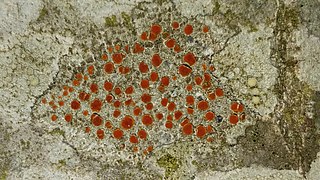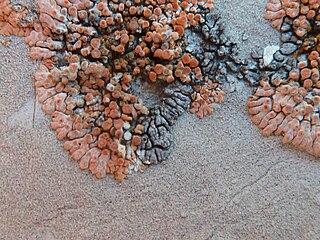
The Teloschistaceae are a large family of mostly lichen-forming fungi belonging to the class Lecanoromycetes in the division Ascomycota. The family has a cosmopolitan distribution, although members occur predominantly in temperate regions. Most members are lichens that either live on rock or on bark, but about 40 species are lichenicolous – meaning they are non-lichenised fungi that live on other lichens. Many members of the Teloschistaceae are readily identifiable by their vibrant orange to yellow hue, a result of their frequent anthraquinone content. The presence of these anthraquinone pigments, which confer protection from ultraviolet light, enabled this group to expand from shaded forest habitats to harsher environmental conditions of sunny and arid ecosystems during the Late Cretaceous.
Vsevolod Pavlovich Savich was a Soviet lichenologist. He headed the Section of Cryptogamic Plants of the Komarov Botanical Institute of the Academy of Sciences of the USSR. Savicz died in Leningrad in 1972. The crustose lichen Caloplaca saviczii is named in his honour.

Blastenia is a genus of lichen-forming fungi in the family Teloschistaceae. The genus was circumscribed in 1852 by Abramo Bartolommeo Massalongo.

Calogaya is a genus of lichen-forming fungi belonging to the family Teloschistaceae. It has 19 species. The genus was circumscribed in 2013 by Ulf Arup, Ulrik Søchting, and Patrik Frödén. The generic name Calogaya honours Dr. Ester Gaya, a Spanish botanist from the University of Barcelona.

Flavoplaca is a genus of crust-like or scaly lichens in the family Teloschistaceae. It has 28 species with a mostly Northern Hemisphere distribution.
Caloplaca saviczii is a species of crustose lichen in the family Teloschistaceae. Found in the Russian Far East, it was formally described as a new species in 2021 by Ivan Frolov, Dmitry Himelbrant, Irina Stepanchikova, Liudmila Konoreva, and Sergey Chesnokov. The type specimen was collected in the fluvial valley of River Katal'yanayvayam ; here, in a floodplain forest, it was found growing on the bark of Populus suaveolens. The specific epithet saviczii honours Russian lichenologist Vsevolod Pavlovich Savich (1885–1972), who studied the lichens of Kamchatka.
Lendemeriella aureopruinosa is a species of crustose lichen in the family Teloschistaceae. Found in the Russian Far East, it was formally described as a new species in 2021 by Ivan Frolov, Jan Vondrák, Ulf Arup, Liudmila Konoreva, and Sergey Chesnokov, Lidia Yakovchenko, and Evgeny Davydov. The type specimen was collected on the banks of River Bes-Yuryakh ; here it was found growing on siliceous outcrops in a forest comprising largely birch, alder, and larch trees. The thallus of the lichen ranges in form from an inconspicuous grey film to a more well-developed crust or areoles. Its apothecia measure 0.3–0.6 mm in diameter and have a dark-orange to brick-red coloured disc. Secondary chemicals detected in the lichen include parietin, parietinic acid, emodin, teloschistin, and fallacinal. The specific epithet aureopruinosa refers to the bright gold-coloured pruina that is found on young apothecia.
Huneckia is a genus of crustose lichens in the subfamily Caloplacoideae of the family Teloschistaceae. It has four species.

Pyrenodesmia is a genus of lichen-forming fungi in the family Teloschistaceae. The genus currently includes 23 recognized species but is believed to contain many more unnamed taxa. The genus was circumscribed in 1852 by Italian lichenologist Abramo Bartolommeo Massalongo. It is characterised by the complete absence of anthraquinones and the presence of Sedifolia-gray pigments in both the thallus and apothecia. These lichens are typically found in calcareous outcrops in the Northern Hemisphere, with biodiversity centres in the Mediterranean basin, Central Asia, and arid regions of western North America.

Calogaya arnoldii is a species of saxicolous (rock-dwelling), crustose lichen that is common and widespread in Europe and Asia. It is in the family Teloschistaceae. It was first formally described as a new species in 1876 by Hugh Algernon Weddell, as a species of Lecanora. After being transferred to Caloplaca in 1915, it was considered as a member of that genus for nearly a century. Molecular phylogenetic studies showed Caloplaca to be polyphyletic, and it was divided up into several smaller genera in 2013. Calogaya arnoldii was one of eight species transferred to the newly circumscribed Calogaya by Ulf Arup, Patrik Frödén, and Ulrik Søchting. The lichen is part of a species complex with complicated taxonomy, and in which intermediate phenotypes are frequently observed, making it difficult to reliably distinguish them. Calogaya saxicola is one such similar species, and it has often been confused with C, arnoldii in areas where they co-occur, as the differences between them are subtle.

Wetmoreana is a genus of lichen-forming fungi in the family Teloschistaceae. It has two crustose, saxicolous (rock-dwelling) species.
Teuvoahtiana is a genus of lichen-forming fungi in the family Teloschistaceae. It contains three species of saxicolous (rock-dwelling), crustose lichens, all of which occur in South America.
Gondwania is a genus of lichen-forming fungi in the subfamily Xanthorioideae of the family Teloschistaceae. It has five species.
Orientophila is a genus of lichen-forming fungi in the family Teloschistaceae. It has 15 species of mostly saxicolous (rock-dwelling), crustose lichens. All Orientophila species occur in Northeast Asia including China, Japan, South Korea, and the Russian Far East.
Kuettlingeria soralifera is a saxicolous (rock-dwelling), crustose lichen species in the family Teloschistaceae, first described in 2006. It is similar to Kuettlingeria xerica but distinguished by the presence of soredia on its thallus.
Oxneriopsis is a genus of lichen-forming fungi in the family Teloschistaceae. It has four species of corticolous (bark-dwelling), crustose lichens.
Loekoesia is a genus of lichen-forming fungi in the family Teloschistaceae. It contains three species of saxicolous (rock-dwelling), crustose lichens. Collectively, the genus occurs in South Korea, Mauritius, and the United States. The genus is distinguished by its grey, crust-like thallus, which can be either whole or divided into patch-like segments. Loekoesia lichens have bright white, rounded soralia, which produce bluish to whitish powdery propagules (soredia) and are arranged in irregular groups on the thallus.

Coppinsiella is a genus of lichen-forming fungi in the family Teloschistaceae. It contains five species of corticolous and saxicolous crustose lichens with a distribution in Europe, Asia, and North America. Coppinsiella bears resemblance to the genus Athallia, but it is distinguished by its more developed thallus, typically featuring distinctive crater-like soralia and zeorine-form apothecia, which lack a thalline margin.
Kuettlingeria neotaurica is a species of saxicolous (rock-dwelling), crustose lichen in the family Teloschistaceae.








